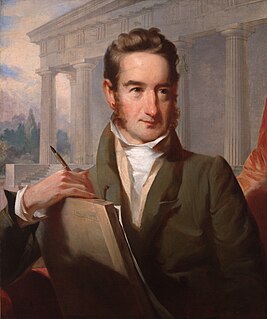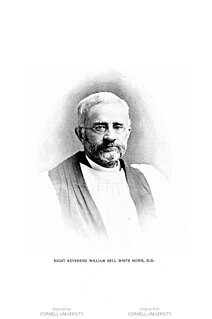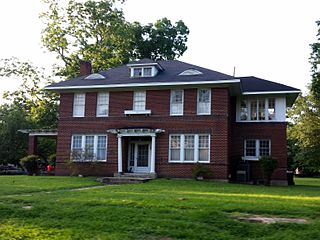Related Research Articles

The Atlantic Coast Line Railroad is a former U. S. Class I railroad formed in 1900, though predecessor railroads had used the ACL brand since 1871. In 1967 it merged with long-time rival Seaboard Air Line Railroad to form the Seaboard Coast Line Railroad. Much of the original ACL network has been part of CSX Transportation since 1986.

William Strickland, was a noted architect and civil engineer in Philadelphia, Pennsylvania, and Nashville, Tennessee. A student of Benjamin Latrobe and mentor to Thomas Ustick Walter, Strickland helped establish the Greek Revival movement in the United States. A pioneering engineer, he wrote a seminal book on railroad construction, helped build several early American railroads, and designed the first ocean breakwater in the Western Hemisphere. He was elected as a member of the American Philosophical Society in 1820.
St. John's Episcopal Church, or variants thereof, can refer to the following:

Russell Warren (1783–1860) was an American architect, best known for his work in the Greek Revival style. He practiced in Bristol and Providence.
Saint Andrew's Episcopal Church, or variants thereof, may refer to:

Edward Brickell White, also known as E. B. White, was an architect in the United States. He was known for his Gothic Revival architecture and his use of Roman and Greek designs.

St. Philip's Church is an historic church at 142 Church Street in Charleston, South Carolina. Its National Historic Landmark description states: "Built in 1836, this stuccoed brick church features an imposing tower designed in the Wren-Gibbs tradition. Three Tuscan pedimented porticoes contribute to this design to make a building of the highest quality and sophistication." On November 7, 1973, it was added to the National Register of Historic Places and designated a National Historic Landmark.

George Edward Harney (1840–1924) was a late 19th-century American architect based in New York City.

Robert W. Gibson, AIA, was an English-born American ecclesiastical architect active in late-nineteenth- and early-twentieth-century New York City and New York State. He designed several large Manhattan churches and a number of prominent residences and institutional buildings.
Hobart Brown Upjohn (1876–1949) was an American architect, best known for designing a number of ecclesiastical and educational structures in New York and in North Carolina. He also designed a number of significant private homes. His firm produced a total of about 150 projects, a third of which were in North Carolina.

Edward Culliatt Jones was an American architect from Charleston, South Carolina. A number of his works are listed on the U.S. National Register of Historic Places, and two are further designated as U.S. National Historic Landmarks. His works include the following :
Henry Emil Bonitz (1872–1921) was an American architect.

For the railroad engineer and architect see W. B. W. Howe, Jr.

Clarke & Howe was an American architectural firm from Providence, Rhode Island that was active from 1893 to 1928.

Estes Wilson Mann Sr. was an American architect based in Memphis, Tennessee. Several buildings he designed are listed on the National Register of Historic Places.
Julian de Bruyn Kops was an architect in Savannah, Georgia. Several of his works are listed on the National Register of Historic Places.

Christ Church is an Episcopal church at 28 Bull Street, Johnson Square, in Savannah, Georgia. Founded in 1733, it was the first church established in the Province of Georgia and one of the first parishes within the Episcopal Diocese of Georgia, earning it the nickname "the Mother Church of Georgia". The present church building was constructed in 1838 and is located in the Savannah Historic District.
References
- ↑ "Poor's Directory of Railway Officials". Poor's Railroad Manual. June 11, 1887 – via Google Books.
- 1 2 Anderson, Dorothy Middleton; Eastman, Margaret Middleton Rivers (May 4, 2015). St. Philip's Church of Charleston: An Early History of the Oldest Parish in South Carolina. Arcadia Publishing. ISBN 9781625854070 – via Google Books.
- ↑ Office, United States Patent (June 11, 1886). "Annual Report of the Commissioner of Patents". U.S. Government Printing Office – via Google Books.
- ↑ "Engineering News and American Railway Journal". Engineering News Publishing Company. June 11, 1896 – via Google Books.
- ↑ "Journal of the ... Annual Council of the Protestant Episcopal Church in the Diocese of South Carolina Held in ..." R.L. Bryan Company. June 11, 1880 – via Google Books.
- ↑ "Engineering News-record". McGraw-Hill Publishing Company. June 11, 1900 – via Google Books.
- ↑ Tomlan, Michael A. (November 21, 2014). Historic Preservation: Caring for Our Expanding Legacy. Springer. ISBN 9783319049755 – via Google Books.